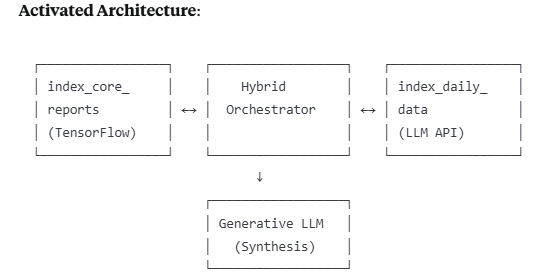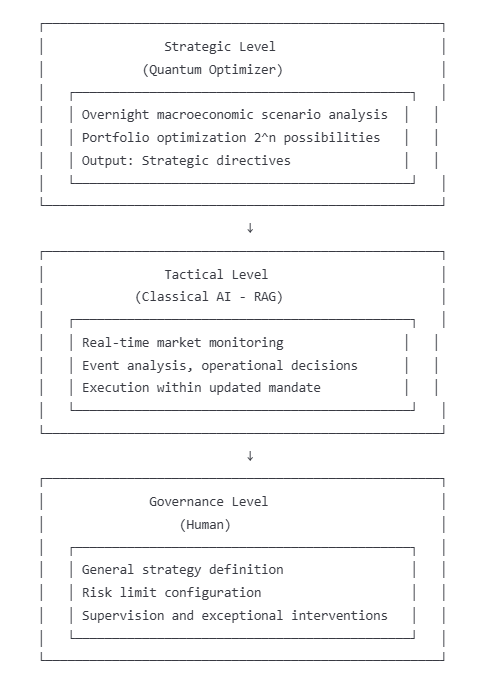Abstract
This research documents the architectural and functional evolution of a financial Digital Twin based on a hybrid RAG (Retrieval-Augmented Generation) architecture. The evolutionary journey encompasses four distinct stages: from Augmented Analyst to Quantum-Enhanced Orchestrator, demonstrating how the fusion of diverse computational paradigms can create decision-making agents of unprecedented power and robustness. The analysis presents a simulated chronology illustrating the progressive growth of system capabilities, from passive response to human queries to autonomous execution of investment strategies guided by quantum optimization.
Keywords: Digital Twin, Hybrid RAG, Financial AI, Quantum Computing, Governed Automation
1. Introduction
The evolution of Artificial Intelligence systems in the financial sector has reached a critical turning point. The central question in modern AI system architecture touches the heart of the trade-off between simplicity, control, and performance. While traditional systems are limited to providing retrospective analysis or passive decision support, there emerges a need for agents capable of evolving from simple consultation tools to autonomous strategic partners.
This study presents the evolution of a financial Digital Twin through four distinct evolutionary stages, each characterized by increasing capabilities of autonomy and decision-making sophistication. The proposed architecture is based on a hybrid RAG approach that combines the strengths of specialized embedding models (TensorFlow) for deep and stable knowledge, with the agility of API-based embedding models for dynamic data.
2. Theoretical Foundations: Hybrid RAG Architecture
2.1 The Strategic Trade-off in Vectorization
The choice of vectorization approach represents a fundamental strategic trade-off. On one hand, using unified LLM providers (like OpenAI) offers extreme simplicity and perfect semantic coherence. On the other hand, adopting dedicated models (TensorFlow) guarantees total control, domain specialization, and long-term stability.
Approach 1: Vectorization via LLM Provider
- Advantages: Implementation simplicity, native semantic coherence, out-of-the-box performance
- Disadvantages: High costs at scale, lack of control, risk of forced obsolescence
Approach 2: Vectorization with Dedicated Models
- Advantages: Total control, customization through fine-tuning, economic efficiency, technological independence
- Disadvantages: MLOps complexity, potential semantic gap with generative LLMs
2.2 The Hybrid Solution: Decision Criteria
The proposed architecture adopts a differentiated vectorization strategy based on specific criteria:
- Data Nature and Stability
- Static and domain data → Dedicated models (TensorFlow)
- Dynamic and volatile data → LLM APIs
- Sensitivity and Privacy
- Sensitive/proprietary data → In-house models
- Public data → Flexible approach
- Task Type
- Deep semantic search → Specialized models
- Conversational queries → LLM providers
3. Methodology: The Evolutionary Chronology
The research adopts a chronological simulation approach to document the progressive evolution of system capabilities. The methodology simulates four consecutive days (June 23-26, 2025), each characterized by an increasing level of autonomy and sophistication.
4. Results: The Four Evolutionary Stages
4.1 Day 1 (June 23): The Augmented Analyst
Scenario: Valeria, a senior financial analyst, poses a complex question requiring correlation between long-term strategic data and real-time market information.
Query: “Analyze MegaCorp’s performance in the context of the annual report and today’s closing”
Activated Architecture:

Process:
- The Orchestrator simultaneously queries
index_core_reports(vectorized with TensorFlow for stability) andindex_daily_data(vectorized with LLM API for agility) - Retrieves relevant text from both sources
- Constructs a contextualized prompt for final synthesis
Demonstrated Capabilities: Passive analysis (Q&A), heterogeneous data fusion, human decision support.
4.2 Day 2 (June 24): The Proactive Partner
Scenario: Valeria delves deeper into the competitive risk between MegaCorp and FutureTech.
Query: “Assess MegaCorp’s competitive risk against FutureTech considering product roadmaps”
Architectural Evolution: The system doesn’t just respond but activates proactive monitoring.
Bimodal Process:
Phase 1 (Reactive):
- Comparative analysis of corporate roadmaps
- Identification of main threat: FutureTech’s “Odyssey” battery
Phase 2 (Proactive):
- Autonomous Trigger: Valeria’s query activates a real-time monitoring task
- Detection: System identifies critical news regarding FutureTech
- Recommendation: Generates structured JSON output for human validation
{
"detected_event": "Odyssey launch delay - 6 months",
"estimated_impact": "Significant reduction in competitive threat",
"recommendation": "MONITOR for tactical opportunities",
"confidence_level": "High"
}
Demonstrated Capabilities: Contextual understanding, proactive monitoring, actionable insight generation, human-in-the-loop collaboration.
4.3 Day 3 (June 25): The Autonomous Agent with Risk Mandate
Scenario: 5:46 PM EST – No human input. Flash news: “FutureTech CEO resigns effective immediately due to strategic differences.”
Critical Evolution: First completely autonomous execution.
Pre-configured Mandate:
{
"ticker": "MCORP",
"max_trade_size_abs": 1000,
"max_trade_impact_pct": 0.5,
"confidence_threshold": "High",
"status": "ACTIVE"
}
Autonomous Decision Process:
- Multi-Source Analysis:
- Fundamentals (TensorFlow): Confirms MCORP solidity
- Market (LLM API): Stable pre-news pricing
- Live News: Destabilizing event for competitor
- Decision Synthesis:
{
"ticker": "MCORP",
"decision": "BUY",
"rationale": "Competitor CEO resignation eliminates main medium-term threat",
"confidence_level": "High",
"quantity": 700,
"mandate_verification": {
"within_limits": true,
"portfolio_impact": "0.45%"
}
}
- Execution: System autonomously submits order via broker API
Demonstrated Capabilities: End-to-end automation, autonomous execution, rule-based risk management (governed automation).
4.4 Day 4 (June 26): The Quantum-Enhanced Orchestrator
Architectural Innovation: Introduction of quantum layer for overnight strategic analysis.
Three-Tier Architecture:

Overnight Quantum Process:
Input: Portfolio positions, correlation matrices, macroeconomic scenarios identified by LLM
Task (Quantum Annealing):
“Given these scenarios and their estimated probabilities, explore all possible future trajectories and identify the portfolio allocation that offers the best risk/return profile (Sharpe Ratio). Indicate which sectoral trends are strategically most robust.”
Quantum Output:
{
"quantum_analysis_id": "QA_20250626_0200",
"confirmed_trend": "Overweight advanced semiconductors for autonomous vehicles",
"quantum_rationale": "Analysis across 2^512 possible paths shows maximum robustness against inflation/slowdown scenarios",
"suggested_mandate_update": {
"ticker": "MCORP",
"new_risk_appetite_factor": 1.5,
"note": "MCORP identified as optimal vehicle to implement confirmed trend"
}
}
Quantum-Enhanced Tactical Action:
When the same event from the previous day occurs (FutureTech CEO resignation), the Tactical Orchestrator now operates with an updated mandate:
{
"ticker": "MCORP",
"decision": "BUY (high priority)",
"rationale": "Tactical-strategic convergence: news validates quantum-confirmed trend",
"confidence_level": "Very High",
"quantity": 1500,
"mandate_verification": {
"within_limits": true,
"rationale": "Operation authorized by post-quantum analysis updated mandate"
}
}
Demonstrated Capabilities: Fusion of tactical (classical AI) and strategic (quantum) analysis, enhanced decision-making process, high-conviction execution based on multi-paradigm validation.
5. Comparative Performance Analysis
| Stage | Response Time | Autonomy | Decision Quality | Risk Management |
|---|---|---|---|---|
| Augmented Analyst | ~30 seconds | 0% | Good | Human |
| Proactive Partner | ~2 minutes | 20% | Good+ | Human+System |
| Autonomous Agent | ~45 seconds | 80% | High | Systematic |
| Quantum-Enhanced | ~60 seconds | 85% | Very High | Multi-paradigm |
6. Implications and Discussion
6.1 Convergence of Computational Paradigms
The documented evolution demonstrates how the convergence of different computational paradigms—contextual perception of classical AI and deep scenario exploration of quantum computing—can create decision-making agents of unprecedented power. The Quantum Optimizer doesn’t replace classical AI but guides it by providing a strategic compass derived from superior complexity analysis.
6.2 Governed Automation vs. Complete Automation
The proposed model demonstrates the effectiveness of governed automation over complete automation. Maintaining human supervision at the strategic level, combined with operational system autonomy, creates an optimal balance between efficiency and control.
6.3 Scalability and Robustness
The hybrid architecture proves scalable through the clear separation between indexing system (TensorFlow for stability) and generation system (cloud LLM for power). This separation ensures that the vectorized knowledge asset remains stable while the decision engine can evolve.
7. Limitations and Future Developments
7.1 Current Limitations
- Quantum Computing: Simulated quantum capabilities require mature quantum hardware
- Semantic Gap: Potential misalignment between heterogeneous embedding models
- System Complexity: Requires multidisciplinary expertise for deployment
7.2 Future Developments
- Integration of real-time sentiment analysis models
- Extension to multiple asset classes (crypto, commodities, FX)
- Implementation of feedback loops for continuous learning
- Development of quantum stress testing for extreme scenarios
8. Conclusions
This study documents the evolution of a financial Digital Twin through four progressive stages of autonomy and sophistication. The proposed hybrid RAG architecture demonstrates how the strategic combination of complementary technologies can overcome the limitations of individual approaches.
The Quantum-Enhanced Orchestrator model represents an innovative paradigm where:
- Classical AI excels in interpreting the “here and now”
- Quantum Optimization explores the “what if” of millions of possible futures
- Humans define the destination and rules of the journey
This convergence of tactical perception, strategic depth, and human governance creates a system capable of operating at speeds and with levels of analysis previously unimaginable, while always maintaining the strategic oversight necessary for responsible financial risk management.
Our Digital Twin is no longer just a trader; it’s a system that fuses tactical perception, strategic depth, and human governance, representing the future of AI-augmented finance.
The progression from passive analyst to autonomous quantum-enhanced orchestrator demonstrates that the future of financial AI lies not in replacing human judgment, but in amplifying it through the intelligent orchestration of complementary computational paradigms. This hybrid approach ensures that as our systems become more sophisticated, they remain grounded in human values and strategic oversight.
This article contributes to the research corpus on financial AI system evolution and presents a replicable framework for developing autonomous yet governed decision-making agents in the financial sector.
RAG (Retrieval-Augmented Generation)
- Paper principale: https://arxiv.org/abs/2005.11401
- Studio Facebook AI: https://ai.facebook.com/blog/retrieval-augmented-generation-streamlining-the-creation-of-intelligent-natural-language-processing-models/
- Survey completo: https://arxiv.org/abs/2312.10997
Quantum Computing in Finance
- IBM Research: https://www.nature.com/articles/s41534-021-00390-4
- Portfolio Optimization: https://arxiv.org/abs/1911.05296
- Quantum Annealing Finance: https://link.springer.com/article/10.1007/s11128-021-03087-1
Digital Twins
- Nature Digital Medicine: https://www.nature.com/articles/s41746-020-0244-4
- IEEE Survey: https://ieeexplore.ieee.org/document/8901113
- MIT Technology Review: https://www.technologyreview.com/2023/03/15/1069823/digital-twins/
Embedding Models & Vector Databases
- Sentence-BERT: https://arxiv.org/abs/1908.10084
- OpenAI Embeddings: https://arxiv.org/abs/2201.10005
- FAISS Facebook: https://arxiv.org/abs/1702.08734
Financial AI & Algorithmic Trading
- Deep Learning Finance: https://www.sciencedirect.com/science/article/pii/S0957417420310344
- AI Portfolio Management: https://www.tandfonline.com/doi/full/10.1080/14697688.2020.1849741
- Automated Trading Systems: https://link.springer.com/article/10.1007/s10479-021-04277-9
Quantum Annealing
- D-Wave Research: https://link.springer.com/article/10.1007/s11128-020-02770-w
- Quantum Optimization: https://arxiv.org/abs/1411.4028
- Finance Applications: https://www.nature.com/articles/s41598-021-99926-x
TensorFlow & MLOps
- TensorFlow Serving: https://arxiv.org/abs/1712.06139
- MLOps Survey: https://arxiv.org/abs/2205.02302
- Production ML: https://proceedings.mlr.press/v97/sculley19a.html
Hybrid AI Architectures
- Neurosymbolic AI: https://www.nature.com/articles/s42256-020-00284-7
- Multi-paradigm Computing: https://dl.acm.org/doi/10.1145/3447772
- Cognitive Architectures: https://link.springer.com/article/10.1007/s10458-021-09515-9



